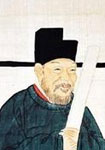《和章友直城東春日》 曾鞏
宋代 曾鞏 東流抱孤城,和章和章和诗雨洗見春色。友直友直原文意風吹百草根,城东春日城东春日道路千裏碧。曾巩
莫盡溪漫漫,翻译波瀾散無跡。赏析
遙林缺見山,和章和章和诗冉冉蒼藹積。友直友直原文意
沙禽有遺蹤,城东春日城东春日文字不可識。曾巩
青鬆對桃李,翻译桃紅李花白。赏析
紅白勢方競,和章和章和诗青青守岩側。友直友直原文意
君意無不諧,城东春日城东春日研談欲俱得。
賦詩多所陳,炳若觀龜坼。
城東不待到,眾物已曆曆。
分類:
作者簡介(曾鞏)

曾鞏(1019年9月30日-1083年4月30日,天禧三年八月二十五日-元豐六年四月十一日),字子固,世稱“南豐先生”。漢族,建昌南豐(今屬江西)人,後居臨川(今江西撫州市西)。曾致堯之孫,曾易占之子。嘉祐二年(1057)進士。北宋政治家、散文家,“唐宋八大家”之一,為“南豐七曾”(曾鞏、曾肇、曾布、曾紆、曾紘、曾協、曾敦)之一。在學術思想和文學事業上貢獻卓越。
《和章友直城東春日》曾鞏 翻譯、賞析和詩意
《和章友直城東春日》是宋代文學家曾鞏創作的一首詩詞。以下是對該詩詞的中文譯文、詩意和賞析:
中文譯文:
東流抱孤城,
雨洗見春色。
風吹百草根,
道路千裏碧。
莫盡溪漫漫,
波瀾散無跡。
遙林缺見山,
冉冉蒼藹積。
沙禽有遺蹤,
文字不可識。
青鬆對桃李,
桃紅李花白。
紅白勢方競,
青青守岩側。
君意無不諧,
研談欲俱得。
賦詩多所陳,
炳若觀龜坼。
城東不待到,
眾物已曆曆。
詩意:
這首詩描繪了一個城東春日的景象。東邊的河流環繞著這座孤零零的城池,雨水洗淨了大地,春色顯現。微風吹動著百草的根,道路延伸千裏呈現一片碧綠。溪水漫過無邊無際,波瀾散去無痕跡。遠處的林木中,山峰隱約可見,蒼翠積聚。河灘上留下了沙禽的足跡,但無法辨認文字。青鬆與桃李相對立,桃花紅豔,李花潔白。紅色和白色的競爭勢頭,而青鬆守護在岩石旁邊。君子的意願沒有不協調的地方,研究和談論欲望都能得到滿足。賦詩描繪了許多事物,如同觀看龜裂的龜殼一樣炫耀。雖然城東的景色還未到達,但周圍的一切已經曆曆在目。
賞析:
這首詩詞以簡潔而生動的語言描繪了一個春日的景色,通過自然景物的描寫表達了作者對大自然的觀察和感受。詩中運用了豐富的自然意象,如東流、雨洗、風吹、百草、溪水、青鬆、桃李等,使讀者仿佛身臨其境,感受到了春日的美好氣息。詩中還運用了對比的手法,如紅白的競爭和青鬆守岩側,展現了自然界中的變化與平衡。整首詩詞表達了作者對自然景物的讚美,以及對生活態度的思考,強調了君子的意願和人與自然的和諧相處。
曾鞏是宋代文學史上的重要作家,他的作品以純熟的藝術技巧和深邃的思想內涵著稱。這首詩詞展示了他對自然景物的細膩觀察和對人生哲理的思考,同時也體現了他對詩詞藝術的造詣。通過欣賞這首詩詞,讀者可以感受到曾鞏的文學才華和對自然美的獨特感悟,同時也能引發對人與自然關係以及生活的思考。注:這個中文詩詞的中文譯文已經提供了,以下是對該詩詞的英文翻譯、詩意和賞析:
English Translation:
Embracing the solitary city by the eastern stream,
Rain-washed, revealing the colors of spring.
The wind blows, grasses deeply rooted,
The roads extend for miles, a thousand-league expanse of green.
Endless streams flow slowly,
Waves dispersing without a trace.
Distant forests reveal glimpses of mountains,
Lush and dense, rising gradually.
Sandbirds leave their traces,
Unrecognizable in written words.
Green pines stand opposite the peach and plum,
Peach blossoms red, plum blooms white.
Red and white vie for dominance,
Green remains steadfast by the cliffs.
Your intentions are always harmonious,
Discussions and studies yield mutual gains.
Your poetic compositions are plentiful,
Brilliant, like the patterns on a tortoise shell.
Before reaching the east of the city,
All things have been clearly experienced.
Poetic Meaning:
This poem depicts the scene of a spring day in the eastern part of a city. The city is embraced by a flowing river, and after the rain, the colors of spring become visible. The wind blows, causing the grass to sway deeply rooted, while the roads stretch for miles, appearing as a green expanse. The meandering streams seem endless, with waves dispersing without leaving a trace. In the distance, the forests reveal glimpses of mountains that gradually accumulate in a lush and dense manner. Sandbirds leave their tracks on the sandy riverbanks, but their footprints cannot be deciphered in writing. Green pines stand opposite peach and plum trees, with peach blossoms in red and plum blossoms in white. The red and white colors compete for dominance, while the green pine remains steadfast by the cliffs. Your intentions are always harmonious, and discussions and studies bring about mutual gains. Your poetic compositions cover a wide range of subjects, shining brightly like the patterns on a tortoise shell. Although the eastern part of the city has not been reached, everything around has been experienced vividly.
Appreciation:
This poem vividly describes the scenery of a spring day using concise and lively language. Through the depiction of natural scenery, the poet expresses his observations and feelings towards nature. The poem employs rich natural imagery, such as flowing streams, rain-washed scenes, blowing wind, grasses, and pine trees, creating an immersive experience for the readers, allowing them to sense the beauty of spring. The poem also utilizes contrasting techniques, such as the competition between red and white and the steadfastness of the green pine, showcasing the changes and balance in the natural world. The entire poem expresses the poet's admiration for natural scenery and contemplation of life's attitudes, emphasizing the harmony between noble intentions and the coexistence of humans and nature.
Zeng Gong, an important writer in the history of Song Dynasty literature, is renowned for his skilled artistic techniques and profound philosophical thoughts in his works. This poem demonstrates his delicate observations of natural scenery and contemplation of philosophical ideas, showcasing his mastery in the art of poetry. By appreciating this poem, readers can perceive Zeng Gong's literary talent, unique insights into the beauty of nature, and be inspired to contemplate the relationship between humans and nature and the meaning of life.
《和章友直城東春日》曾鞏 拚音讀音參考
hé zhāng yǒu zhí chéng dōng chūn rì
和章友直城東春日
dōng liú bào gū chéng, yǔ xǐ jiàn chūn sè.
東流抱孤城,雨洗見春色。
fēng chuī bǎi cǎo gēn, dào lù qiān lǐ bì.
風吹百草根,道路千裏碧。
mò jǐn xī màn màn, bō lán sàn wú jī.
莫盡溪漫漫,波瀾散無跡。
yáo lín quē jiàn shān, rǎn rǎn cāng ǎi jī.
遙林缺見山,冉冉蒼藹積。
shā qín yǒu yí zōng, wén zì bù kě shí.
沙禽有遺蹤,文字不可識。
qīng sōng duì táo lǐ, táo hóng lǐ huā bái.
青鬆對桃李,桃紅李花白。
hóng bái shì fāng jìng, qīng qīng shǒu yán cè.
紅白勢方競,青青守岩側。
jūn yì wú bù xié, yán tán yù jù dé.
君意無不諧,研談欲俱得。
fù shī duō suǒ chén, bǐng ruò guān guī chè.
賦詩多所陳,炳若觀龜坼。
chéng dōng bù dài dào, zhòng wù yǐ lì lì.
城東不待到,眾物已曆曆。
網友評論
* 《和章友直城東春日》和章友直城東春日曾鞏原文、翻譯、賞析和詩意专题为您介绍:《和章友直城東春日》 曾鞏宋代曾鞏東流抱孤城,雨洗見春色。風吹百草根,道路千裏碧。莫盡溪漫漫,波瀾散無跡。遙林缺見山,冉冉蒼藹積。沙禽有遺蹤,文字不可識。青鬆對桃李,桃紅李花白。紅白勢方競,青青守岩側 的古诗全文、翻译备注、注释释文、拼音读音、品鉴赏析、古诗诗意以及网友评论信息。
《和章友直城東春日》和章友直城東春日曾鞏原文、翻譯、賞析和詩意原文,《和章友直城東春日》和章友直城東春日曾鞏原文、翻譯、賞析和詩意翻译,《和章友直城東春日》和章友直城東春日曾鞏原文、翻譯、賞析和詩意赏析,《和章友直城東春日》和章友直城東春日曾鞏原文、翻譯、賞析和詩意阅读答案,出自《和章友直城東春日》和章友直城東春日曾鞏原文、翻譯、賞析和詩意的作品
版权声明:本文内容由网友上传(或整理自网络),原作者已无法考证,版权归原作者所有。就爱诗词网网免费发布仅供学习参考,其观点不代表本站立场。
转载请注明:原文链接 | https://dd110.com/chengyu/044d39987788366.html
诗词类别
《和章友直城東春日》和章友直城東的诗词
- 《同年毛洵勾簿新建》同年毛洵勾簿新建宋祁
- 《春陰》春陰黃庚原文、翻譯、賞析和詩意
- 《病後謝友人顧問》病後謝友人顧問黃庚原文
- 《清水舖瀑布》清水舖瀑布郭印原文、翻譯、
- 《舍北望牛頭山山有延勝寺先太傅書堂在焉六
- 《睡起》睡起黃庚原文、翻譯、賞析和詩意
- 《次劉子翼韻》次劉子翼韻郭印原文、翻譯、
- 《諸公以嵩師破戒作詩嘲詠因次韻解之》諸公
- 《曉坐》曉坐陸遊原文、翻譯、賞析和詩意
- 《同蕭憲父明舉聯句》同蕭憲父明舉聯句郭印
热门名句
- 《送韓梓秀才十八韻》送韓梓秀才十八韻陸遊
- 《寄徐雪江珦潛山老友》寄徐雪江珦潛山老友
- 《蝶》蝶黃庚原文、翻譯、賞析和詩意
- 《送慈州茅主簿入道》送慈州茅主簿入道黃庚
- 《承示中秋不見月及憫雨連作恐妨秋成奉次元